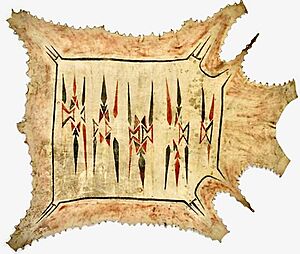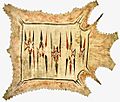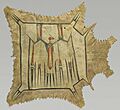Illinois Confederation facts for kids
|
Illiniwek
|
|
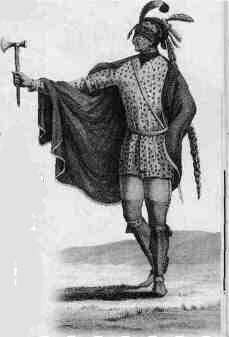
Engraving from drawing by General Georges-Henri-Victor Collot (1796)
|
|
| Successor | Peoria Tribe of Indians of Oklahoma |
|---|---|
| Formation | 5 |
| Type | Tribal alliance |
| Location | |
| Origins | Mississippi River Valley |
|
Membership
|
|
|
Official language
|
Miami-Illinois language |
|
Main organ
|
Great Chief and lower peace chiefs and war chiefs |
The Illinois Confederation, also known as the Illiniwek or Illini, was a group of 12 to 13 Native American tribes. They lived in the Mississippi River Valley. Over time, their lands stretched from Lake Michigan to parts of Iowa, Illinois, Missouri, and Arkansas. The five main tribes were the Cahokia, Kaskaskia, Michigamea, Peoria, and Tamaroa. The name "Illinois" comes from a French version of the native word iliniwe.
Like many Native American groups, the Illinois people got their food by farming, hunting, and fishing. They were partly nomadic, meaning they moved around. They lived in longhouses and wigwams, depending on the season and what resources were nearby. Men usually hunted or went to war. Women grew and prepared crops, made tools and clothes from animal hides, and stored food. The villages were led by one Great Chief, and each individual clan had its own chief. The Illinois population sadly decreased due to new diseases and wars, often brought by French colonists.
Eventually, the remaining Illinois people reorganized and are now known as the "Peoria Tribe of Indians". They live in Oklahoma today.
Contents
What Does "Illinois" Mean?
French missionaries who wrote about their meetings with the tribes noted that the people called themselves Inoka. The meaning of this word is not known. Jacques Marquette, a French missionary, thought Illinois came from Illini in their Algonquian language. He said it meant 'the men'. Another explorer, Louis Hennepin, believed it meant strong, mature men.
However, modern language research shows that Illinois actually comes from irenweewa. This word means 'he speaks in the ordinary way'. The Ojibwe people, who lived nearby, pronounced this word in a way that sounded like ilinwe to the French. Ilinwe is the singular form of ilinwek. Early French explorers wrote it down in different ways, like "liniouek" and "Iliniouek". The singular form eventually became the familiar "Illinois".
History of the Illinois People
How the Tribes Formed
The Illinois Confederation was made up of 12 different tribes. They all spoke a similar language and shared a common culture. These tribes included the Kaskaskia, Cahokia, Peoria, Tamaroa, Moingwena, Michigamea, Chepoussa, Chinkoa, Coiracoentanon, Espeminkia, Maroa, and Tapouara. Out of these 12, only the Cahokia, Kaskaskia, Michigamea, Peoria, and Tamaora still exist as distinct tribes. The others were lost due to disease and wars.
When Europeans first met the Illinois in the 1600s, there were about 10,000 people. Although their numbers are much smaller now, many of their descendants are part of the Peoria Tribe of Indians in Miami, Oklahoma.
Meeting Europeans
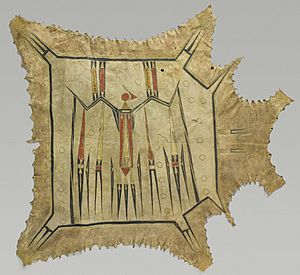
When the French first met the Illiniwek tribes, it's believed there were as many as 10,000 members. They lived in a huge area from Lake Michigan down to Iowa and as far south as Arkansas. In the 1670s, the French found a Kaskaskia village in the Illinois River valley. They also found a Peoria village in Iowa and a Michigamea village in northeast Arkansas.
The Kaskaskia village, also called the Grand Village of the Illinois, was the largest and most famous Illinois village. In 1675, the French set up a Catholic mission and a fur trading post near this village. The population grew to about 6,000 people living in about 460 houses. However, European diseases and ongoing conflicts like the Beaver Wars caused many Illiniwek to die. Their population dropped sharply in the following years.
The French called the area Pays de Illinois, or "Illinois country." This became a common name for the Illinois homeland. Early French explorers like Louis Jolliet, Jacques Marquette, and René-Robert Cavelier, Sieur de La Salle wrote about their first encounters with the Illinois. Because of these meetings, the Illinois tribes became well known to European explorers. European ways of life, values, and religion began to influence the tribes.
In the late 1600s, the Iroquois, who wanted to expand their lands and control the fur trade, forced the Kaskaskia and other Illinois tribes out of their villages. The Illinois moved south. Even though the Illinois fought back against their main enemy, these wars scattered and killed many of their people. Eventually, they were able to reclaim some of their lands.
In the early 1700s, the Illinois became involved in a conflict between the Meskwaki (also known as "Fox") and the French. This was known as the Fox Wars. In 1722, the Meskwaki attacked the Peoria. They forced them onto Starved Rock. The Peoria sent messages asking the French for help. But by the time help arrived, many Peoria warriors had been killed. The French and their allies, including the Illini, Miami, Potawatomi, and Sac, continued to fight the Meskwaki. They were not successful until 1730. That year, they attacked a Fox village on the Sangamon River in a fierce battle.
By the mid-1700s, the 12 or 13 tribes of the Confederation had shrunk to just five: the Cahokia, Kaskaskia, Michigamea, Peoria, and Tamaroa. European diseases greatly reduced the number of Illinois people. The wars happened because tribes fought over resources and trade goods, or because European explorers started conflicts to expand their land. The remaining descendants of the Illinois Confederation have joined with the Peoria. They are now known as the Peoria Tribe of Indians and live in Ottawa County, Oklahoma.
The End of the Confederation
Some of the Illinois people's main enemies were the Lakota (Sioux), Osage, Pawnee, Sac and Fox Nation, and Arikara to the west. To the south were the Quapaw, Shawnee, and Chickasaw. While these tribes were constant threats, the Iroquois became the most serious enemy of the Illinois starting in the late 1600s. The Iroquois were looking for new hunting grounds after using up their own resources. They killed or captured many Illinois people through their war parties. This taking of land and people eventually pushed the Illinois out of the Great Lakes region and into what is now Kansas. Besides conflicts among the tribes themselves, the Illinois also faced threats from European forces. These forces caused conflicts and started wars, sometimes recruiting the Illinois as allies.
Also, with more contact with Europeans and the Iroquois, the Illinois were exposed to many new diseases. These diseases caused many deaths among them. Through war and foreign disease, the Illinois population dropped greatly. By 1778, they were down to a village of about 300 people. Pushed out by the Iroquois and Shawnee, and facing more European settlers, the Illinois accepted a reservation in 1832. This was near the Big Muddy River south of Kaskaskia. But within a few months, they gave up the rest of their territory. They moved to settle on a reservation in Eastern Kansas.
In 1854, the Illinois joined with the Wea and Piankashaw nations. They renamed themselves the Confederated Peoria Tribe. In 1867, they moved to a new reservation in Northeast Oklahoma. Members of the Miami Tribe later joined them, becoming an official part of their new group in 1873. The United Peoria and Miami Tribe lasted about 50 years, dissolving in the 1920s. The remaining members of the Peoria Confederation reorganized. They sought official recognition from the U.S. government and were officially acknowledged by 1978. The descendants of the Illinois Confederation are found today within the Peoria in Ottawa County, Oklahoma.
Illinois Culture
Language and Communication
Miami and Illinois are different forms of the same Algonquian language. This language was spoken in Indiana and later in Oklahoma. Even though there are no native speakers of the language left, people are working to bring it back. Children from both the Miami and Peoria nations are learning to speak their ancestors' language again. Miami-Illinois is a complex language with many parts to its verbs and a fairly flexible word order.
The Algonquian language family is a group of Native American languages. They were spoken in Canada, New England, the Atlantic coast, and the Great Lakes region, extending towards the Rocky Mountains. There are many Algonquian languages, such as Cree, Ojibwa, Blackfoot, and Cheyenne. The term "Algonquin" is sometimes used to refer to a specific form of Ojibwa, which the Illinois people used.
Roles of Men and Women
Like most Native American tribes, Illinois men were mainly hunters and warriors. Women had roles in the home and in farming. However, historical records show that some women also held leadership positions, including those for spiritual ceremonies. In families where a man had more than one wife, the first wife often had a special role in the household. Some women were also spiritual leaders or healers, holding great respect in the community.
Women sometimes helped with communal hunts, but they did not use weapons. Outside of spiritual roles, women could gain status in the village through their domestic skills and successful harvests. Growing plenty of food, raising many children, and being a supportive wife were signs of high status and respect. Men, on the other hand, gained status through their achievements in battle and by showing courage. Their hunting skills could also lead to greater respect in the villages.
Some Illinois men took on roles traditionally associated with women. These individuals were called the Ikoneta. Young boys who showed interests in these roles were sometimes raised in ways that included clothing and activities often done by girls. They were also taught language patterns specific to women.
Religion and Beliefs
People of all social roles were very religious. They relied on spiritual guidance for almost every part of their lives. Hunters asked spirits for help in catching animals. Warriors prayed to spirits before battles. Spiritual leaders were often consulted for health and well-being. However, when European missionaries arrived in the late 1600s, they set up missions to convert the Illinois to Christianity. While many tribes eventually converted, some tribal elders chose to keep their traditional beliefs in the spirit world.
Important Traditions
Illinois men and women practiced a ritual called dream seeking. In this tradition, young boys and girls around 15 years old would paint their faces and go off alone. They would fast and pray to find a special spirit guardian. This guardian, called a manitou, would guide them for the rest of their lives. This vision quest was a very important part of becoming an adult for the Illinois people.
The Illinois had two ways of burying their dead. One was for bodies that were still whole. The other was for skeletons that had been placed on special platforms before the burial ceremony. Only people of the same gender and age as the person who died could be part of the burial crew. For whole bodies, the person was dressed in special clothes and placed in their grave with objects to go with them into the afterlife. A wooden cover was placed over the grave to protect it from animals and weather.
Illinois Society
Economy and Trade
The Illinois people's economy was based on farming, hunting, and fishing. They relied heavily on farming. Their villages were usually near rivers where the soil was very fertile. Corn was their main crop, but the Illinois also planted beans, squash, pumpkins, and watermelons. They also gathered wild foods from the forests. Corn was planted in late spring. Some was harvested early in July and preserved for the winter. A second harvest collected ripe corn, which was eaten during warmer months. Fish were plentiful in the Illinois River, but fishing was not their main food source. Hunters mostly hunted bison, which were common in the northern Illinois prairies.
Hunting trips could be done by individuals or groups. Sometimes, large communal hunts involved up to 300 people, including women. In bison hunts, groups would split up and surround the bison on foot. When close enough, hunters would shoot arrows and spears, driving the animals towards the rest of the hunting party. The women's job was to butcher the bison. They would preserve the meat by drying and heating it to prepare for winter, when hunting was harder.
When Europeans first arrived, the Illinois economy was mostly self-sufficient. This means they produced almost all the food and goods they needed for their way of life. However, the Illinois also traded a lot. They exchanged animal hides, furs, and sometimes captives from tribes to their south and west. In return, they traded with Great Lakes tribes and French traders for guns and other European goods. Over time, traders and missionaries settled among the Illinois. Their economy became more and more dependent on their French allies.
The Illinois lived in wigwams and longhouses at different times of the year. This depended on the weather and available resources. Like most other tribes, they lived in villages with homes shared by several families.
Warfare and Conflict
In early February, war chiefs from each tribe organized raids against enemies. These included the Pawnee and the Quapaw, and later, the five tribes of the Iroquois Confederacy. Before each battle, 20 warriors were invited by the war chief to a feast. There, the men would pray to their manitou for strengths like speed and endurance in battle. For larger conflicts, war parties with both men and women were organized in the villages. The Illinois preferred capturing prisoners over killing them, though some prisoners were eventually killed or forced into slavery. The Illinois preferred arrows and spears over guns, finding them slower. However, the loud noise of guns was sometimes used to scare other tribes who had never heard such a weapon before a battle.
Government and Leadership
Although exact dates are unknown, the Illinois Confederation was once one large nation without smaller tribal divisions. They divided into smaller groups when their population became too large for effective hunting and farming. But even after splitting, all the tribes felt strongly connected as one Illini nation. Their government had one central leader, called the Great Chief. Under him were other Chiefs who led each individual tribe. One famous Great Chief in European history was Mamantouensa, who even traveled to France.
Peace chiefs were in charge of organizing communal hunting trips and talking with leaders from other tribes. While highly respected, peace chiefs did not have the same power as village chiefs. They made decisions through persuasion rather than force. War chiefs had the power to plan and lead raids on other tribes. These roles were not passed down through families. Instead, they were earned by showing great battle skills and convincing other warriors that their manitou could lead them to a successful raid. If someone died in battle, it was the war chief's job to give gifts to the family of the deceased. They would also lead another raid against those who killed the warrior to get revenge. Mostly, only men could be chiefs, but women sometimes held leadership roles in the community as village chiefs.
Even though chiefs had political power and were respected, the Illinois society was quite equal. Important decisions affecting the community were made by agreement among the tribe. It was only when European ideas spread and French officials had direct contact that chiefs began to have more power over their people. By the 1760s, a new chief had to be approved by colonial authorities.
A true confederation means different groups of people who are linked as one nation but are culturally distinct. By this definition, the Illinois were more like a single tribe divided into segments rather than a true confederation. They shared a common language and similar culture across all their groups. Instead of having many individual tribal leaders with full authority, the Illinois also had one Grand Chief who held central power over all the tribes.
Where They Lived
There are different reports about the number of villages and populations of the Illinois, both for individual tribes and the group as a whole. When Europeans first wrote about the nation, the Illinois had villages along the Mississippi and Illinois Rivers. Their population was about eight or nine thousand. However, another report counted only five villages and about two thousand people. The first report is thought to be more accurate, suggesting the Illinois numbered about 10,500 people when Europeans first arrived.
Images for kids
See also
 In Spanish: Illiniwek para niños
In Spanish: Illiniwek para niños


